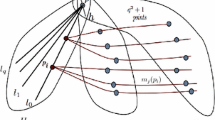Abstract
Let k, v, t be integers such that k ≥ v ≥ t ≥ 2. A perfect hash family \({\mathsf{PHF}}\)(N; k, v, t) can be defined as an N × k array with entries from a set of v symbols such that every N × t subarray contains at least one row having distinct symbols. Perfect hash families have been studied by over 20 years and they find a wide range of applications in computer sciences and in cryptography. In this paper we focus on explicit constructions for perfect hash families using combinatorial methods. We present many recursive constructions which result in a large number of improved parameters for perfect hash families. The paper also includes extensive tables for parameters with t = 3, 4, 5, 6 of newly constructed perfect hash families.
Similar content being viewed by others
References
Alon N. (1986) Explicit construction of exponential sized families of k-independent sets. Discrete Math. 58, 191–193
Atici M., Magliveras S.S., Stinson D.R., Wei W.D. (1996) Some recursive constructions for perfect hash families. J. Combin. Designs 4, 353–363
Barwick S.G., Jackson W.-A. (2007) A sequence approach to linear perfect hash families. Des. Codes Cryptogr. 45, 95–121
Blackburn S.R. (1999) Combinatorics and threshold cryptography, Combinatorial designs and their applications. Chapman Hall Res. Notes in Math. 403, 49–70
Blackburn S.R. (2000) Perfect hash families: probabilistic methods and explicit constructions. J. Combin. Theory A 92, 54–60
Blackburn S.R., Burmester M., Desmedt Y., Wild P.R. (1996) Efficient multiplicative sharing schemes, Advances in Cryptology-Eurocrypt’96. Lect. Notes Comput. Sci. 1070, 107–118
Blackburn S.R., Wild P.R. (1998) Optimal linear perfect hash families. J. Combin. Theory A 83, 233–250
Brickell E.F.: A problem in broacast encryption, 5th Vermont Summer Workshop on Combinatorics and Graph Theory, June 1991.
Chateauneuf M., Kreher D.L. (2002) On the state of strength-three covering arrays. J. Combin. Designs 10, 217–238
Colbourn C.J., Dinitz J.H.: Handbook of Combinatorial Designs, 2nd edin Chapman & Hall/CRC, (2007).
Colbourn C.J., Martirosyan S.S., van Trung T., Walker II R.A. (2006) Roux-type constructions for covering arrays of strengths three and four, Des. Codes Cryptogr. 41, 333–57
Czech Z.J., Havas G., Majewski B.S. (1994) Perfect hashing. Theor. Comp. Sci. 182, 1–143
Fiat A., Naor M. (1994) Broadcast encryption, Advances in Cryptology-Crypto’93. Lect. Notes Comput. Sci. 773, 480–491
Fredman M., Komlós J. (1984) On the size of separating systems and families of perfect hash functions. SIAM J. Disc. Methods. 5, 61–68
Körner J., Marton K. (1988) New bounds for perfect hashing via information theory. Europ. J. Combinatorics 9, 523–530
Martirosyan S.S.: Perfect Hash Families, Identifiable Parent Property Codes and Covering arrays, Ph.D. Thesis, Instiute for Experimental Mathematics, Universität Duisburg-Essen, Germany, October 2003.
Martirosyan S., Martirosyan S.S.: New upper bounds on the cardinality of k-separated set of perfect hash family and a near optimal construction for it. Transactions of IPIA of NAN RA & YSU Math. Probl. Comput. Sci. XXI 104–115 (2000).
Martirosyan S.S., van Trung T. (2004) On t-covering arrays. Des. Codes Cryptogr. 32, 323–339
Mehlhorn K.: On the program size of perfect and universal hash functions. In: Proceedings of the 23rd IEEE Symposium on Foundation of Computer Science (FOCS’82) pp. 170 – 175 (1982).
Mehlhorn K. (1984) Data structures and algorithm 1: sorting and searching. Springer-Verlag, Berlin
Safavi-Naini R., Wang Y. (2000) Sequential traitor tracing, Advances in Cryptology-Crypto’00. Lect. Notes Comput. Sci. 1880, 316–332
Stinson D.R., van Trung T., Wei R. (2000) Secure frameproof codes, key distribution patterns, group testing algorithms and related structures. J. Statist. Plann. Inference 86, 595–617
Stinson D.R., Wei R., Zhu L. (2000) New constructions for perfect hash families and related structures using combinatorial designs and codes. J. Combin. Designs 8, 189–200
Tonien D., Safavi-Naini R. (2006) Recursive constructions of secure codes and hash families using difference function families. J. Combin. Theory A 113, 664–674
van Trung T., Martirosyan S.S. (2005) New constructions for IPP codes. Des. Codes Cryptogr. 35, 227–239
Walker II R.A.: \({\mathsf{PHF}}\) Tables: http://www.phftables.com
Walker II R.A.: Covering arrays and perfect hash families, Ph.D. thesis, Department of Computer Science, Arizona State University, USA, December 2005.
Walker II R.A., Colbourn C.J. (2007) Perfect hash families: constructions and existence. J. Math. Cryptol. 1, 125–150
Wang H., Xing C. (2001) Explicit constructions of perfect hash families from algebraic curves over finite fields. J. Combin. Theory A 93, 112–124
Author information
Authors and Affiliations
Corresponding author
Additional information
Communicated by P. Wild.
Rights and permissions
About this article
Cite this article
Martirosyan, S., van Trung, T. Explicit constructions for perfect hash families. Des. Codes Cryptogr. 46, 97–112 (2008). https://doi.org/10.1007/s10623-007-9138-6
Received:
Revised:
Accepted:
Published:
Issue Date:
DOI: https://doi.org/10.1007/s10623-007-9138-6




